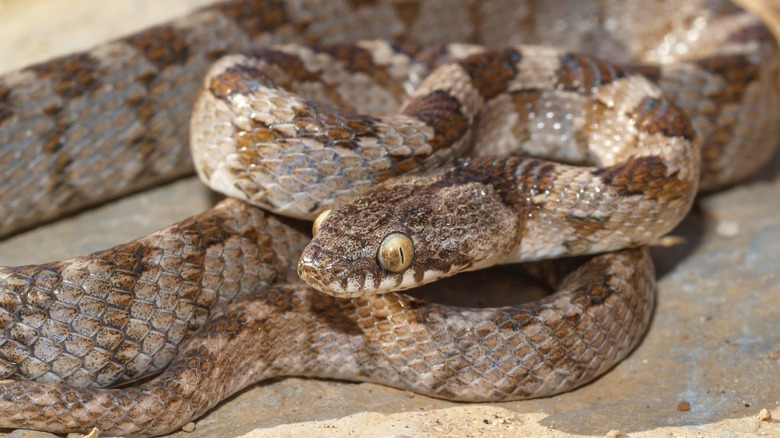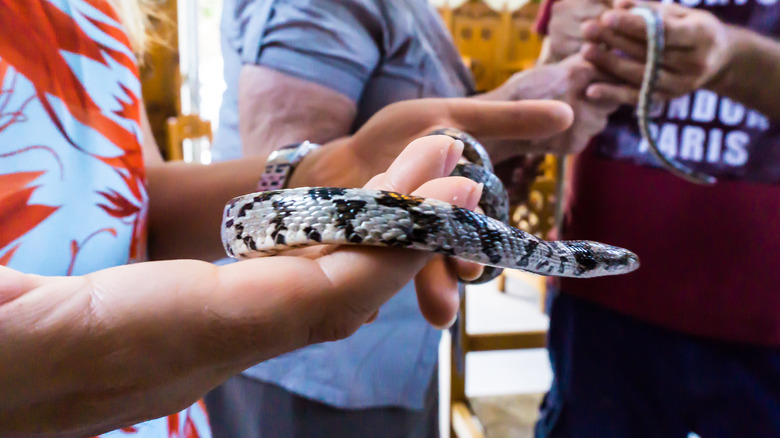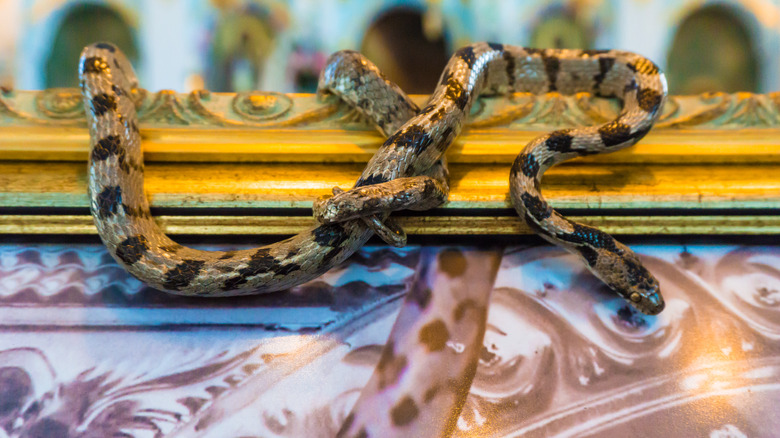The Truth About The Greek Village Where Snakes Come To Church
Snakes have long have a connection to religion. In the Bible, the Devil takes the form of a serpent to tempt Eve and gets humans banished from Eden. And then there's Ireland's patron saint, St. Patrick, who managed to banish all snakes from the island after being attacked by them (per History).
Plenty of mythological snakes have a place in culture and literature too, from monstrous sea serpents, to Medusa and her head of snakes, to the feathered serpent of Mesoamerican cultures. A small number of charismatic Protestant rural churches in the southern U.S. states practice snake handling as part of their services and as a test of faith (per The First Amendment Encyclopedia).
As you can see, snakes and religion aren't strangers to each other, though it's safe to say snakes have usually been linked to all kinds of dark things. But in a small town on the Greek island of Kefalonia, the appearance of snakes in church is taken as a good sign. Every year in the middle of August, snakes appear in the monastery church of the Virgin Mary of Langouvarda (via Greek Reporter). According to the Catholic News Agency, a large number of European Cat Snakes show up at the church around August 15 every year. The snakes, which are small and black, have a cross-like pattern on their head, adding to the myth that there's something "holy" about their appearance.
How it all started
The story of the snakes venerating the "Virgin of the Snakes" icon — "Panagia Fidousa," as the locals call it — starts a long, long time ago. Catholic News Agency cites 1705; Greek Reporter sets the incident in 1200. Either way, the legend goes that pirates were about to attack the local monastery. The nuns living there, worried about their safety, started praying to the Virgin Mary for a miracle (per Greek Reporter). Though the praying didn't keep the pirates from attacking, when they arrived at the monastery, they found it full of snakes. Apparently not a fan of the slithering creatures, the pirates fled and never returned to the island (via Greek City Times). The most popular story says the snakes appeared as a response to the nuns' prayers, a gift from the Virgin Mary to protect them. An alternate story says the nuns themselves were transformed into snakes and defended their own convent.
If it seems surprising that snakes turned out to be a good omen in this story, keep this in mind: According to the Armstrong Institute of Biblical Archaeology, the snake was a symbol of healing in ancient Greece, which is why the official logo of the World Health Organization (WHO) contains a snake. The image comes from the Greek god of healing, Asclepius, who carried a rod with a snake wrapped around it.
Regardless of what really happened in 1705 (or 1200), the snakes have been appearing at the church every year since. The story goes that they appear to "venerate" an image of the Virgin Mary, according to the Catholic News Agency.
It's all quite mysterious
The Greek Orthodox Church celebrates the ascension of the Virgin Mary, known as the "Dormition of the Theotokos," on August 15. According to the Bible, after the Virgin Mary died (which is now referred to as her "repose" or "dormition," rather than her death), her body was taken to heaven to reunite with her soul (via The Greek Orthodox Archdiocese of America).
In Greece, churches celebrate the feast of the Dormition between August 5 and August 15, and it's during this period that the snakes appear every year. They are said to mostly gather inside the church around the Virgin Mary icon and are friendly and not scared of people. In fact, they're allowed to move freely inside the property and people can even touch them, as told via The Greek Reporter. Once the feast is over, the snakes disappear just as mysteriously as they appeared until the next year, says the Catholic News Agency.
The appearance of the snakes is happily celebrated by the locals, who fear that something bad would happen if the snakes don't show up. According to The Greek Reporter, the snakes have only failed to appear twice: during World War II in 1940 and again in 1953, when a major earthquake hit the area. You can surely understand why the snakes' appearance is received with a sigh of relief.


